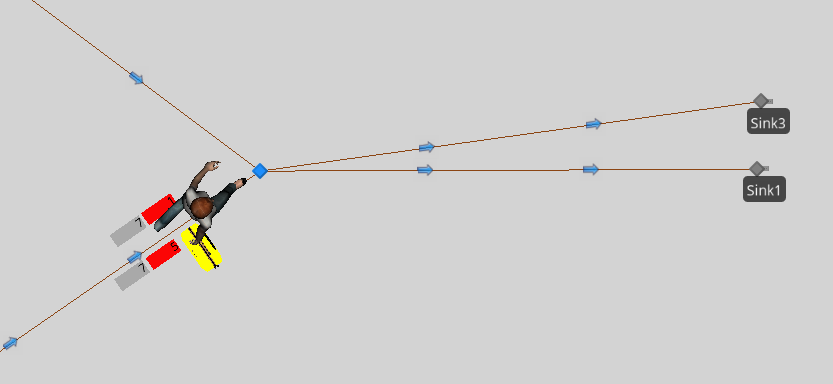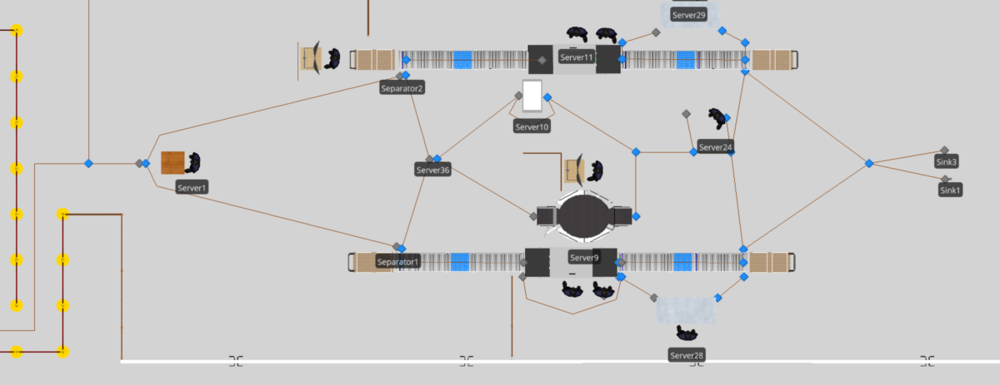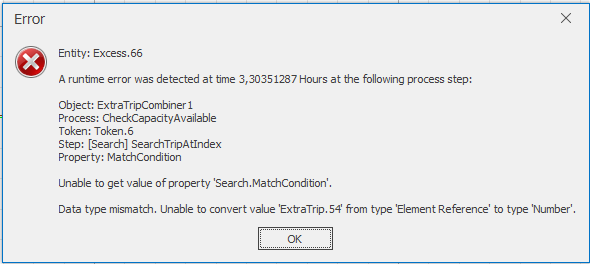Search the Community
Showing results for 'remove parent'.
-
Just curious if there's an easier way to go about doing this... Long story short if I am representing multiple physical positions within capacity of a server and I create my own Gantt outside Simio, it's important for me to know WHICH resource (in this case which one of the servers) is utilized by each entity. I was trying to utilize Entity.Location.Parent.Server.Processing.Contents.IndexOfItem( Entity ) and assigning it to a state on the entity and then ultimately writing to an output table. However, this doesn't seem to be working accurately. It may be a timing issue on when this step is called, but is there a default function I'm just not aware of that could be of assistance?
-
Hello, I ran into a similar problem and am finding it difficult to construct a match expression for the combiner. I want to model a gear assembly GA(parent node) with gear g1, g2, and g3 (all connected to member node). But, there is some upstream variation affecting mating of gears. So, business process is binning them say g1-bin1 through g1-bin5. Similarly g2-bin1 through g2-bin5 and g3-bin1 through g3-bin5. I am currently using matching bin expression but stuck with the combiner is giving me GA1 = g1-bin2, g1-bin2, g2-bin2 which is wrong. How can I tweak so that I can get GA1 = g1-bin2, g2-bin2, g3-bin2. To be clear - There are thousands of g1, g2 and g3 (outsourced parts). I do not want to match some 'source entity counter' because that would assign a unique number to each gear and over-constrain the matching process. Again this might be a rather simple problem but as a beginner modeller I would appreciate a quick hint. Thanks, Hrushi
-
Conditional Routing (by link weight) is not working
AlexDCave replied to AlexDCave's topic in SI General Discussions
Hello, In response to JBeltran: I can figure out how to grab the variable member.priority. If I was able to do that, the rest would be easy I think. I played around with the search function and it didn't seem to work (maybe I am using it wrong?) In response to ATSProThiede: The instance I uploaded was only using the InitialPriority because that was my latest attempt. I had attempted other options that I noted in the OP. Also, you can change the InitialPriority away from 0 in the entity's options. My problem is that only the parent's values are able to be seen. I have no criteria to change the ModelEntity.Priority because the decision needs to be based off of the entity type of the member. The file you attached does not work properly. I turned off the H1BUnits source, so everything should go to packlane1, yet some go to packlane2 or even bypass both to the sink. I have done quite a bit of digging and have found probably 3-4 other feeds that were never answered as member data seems to be difficult to access. Thank you both for the feedback. Please let me know if you have other ideas or I didn't properly test your reply. Best regards, Alex -

Conditional Routing (by link weight) is not working
ATSProThiede replied to AlexDCave's topic in SI General Discussions
*If you need a custom logic, because you have a lot of batch members, you can add a entered process in the node. Then you can use a search step and search your right member. Then you can use a Decide-Step or what else and use the "SetNode-Step" and not the link weight logic. So you can set the taget destionation with the SetNode-Step :-). Or, you write the state in the Parent-Entity after these Entitiy left the Combiner. They are different options to solve this problem. -

Conditional Routing (by link weight) is not working
JBeltran replied to AlexDCave's topic in SI General Discussions
Hello Alex, You cannot directly see the variables of a member which is inside a batch unless you use a process looking for it (with a Search and extracting the required value) An easier method is to transfering the value of the variable of interest (Member.Priority) to the holding Parent (for exemple, onto Parent.My1stMemberPriority) and run your decision logic pointing to it. Regards, -
The conditional routing by link weight (PackFeed2 - Conveyor22 or Conveyor 23; PackFeed4 - Conveyor26 or Conveyor27) is not working for me. The current file is set to make the decision by initial priority, but I have tried other methods with no success: > Assign ModelEntity.Priority with addon process, then route by link weight of ModelEntity.Priority=="X" > Assign link weight by ModelEntity.EntityType > Assign link weight by ModelEntity.BatchMembers.Contains("X") I think this may not be working because they are arriving as a parent/member batch. Is there a different link weight condition that may work. Please note I have 1 parent type and 2 member types. The decision needs to based off of the member entity. The area of concern is towards the end of the process at the top left of the simio (file attached). APS Design 2.spfx
-
I have recreated a system to see theoretical capacities and it has multiple sources (1 parent and 2 different members that I combine). I have turned off balking because that interferes with my unit mix. I have also changed all buffers to a finite number and crossing logic capacities to 1. Even with all of this, I still hit the 2500 max entities and an error pops up. This system should only be able to hold a couple hundred, so I know I don't need to adjust my capacity size. I made the units stop at the 1st server so I could isolate the issue and it appears to be upon creation or in the combiner. My question is, how can I have unit production pause (not stop) when the buffers and capacities are full? I have attached the file for reference. APS Design 2.spfx
-
Hello, I have recently encountered an issue while simulating an airport checkpoint and thus leading to the following question: Is it possible to match member and parent priorities under certain conditions? I am trying to differentiate between those travelers (parent entity) and baggage (member entity) going though an additional screening process prior to exiting the model. Take the following image as an example. I managed to provide a priority (red status label) to those entities going through the additional screening while also providing a rule for those with a priority of 5 to exit though Sink 3 (Those with a priority of 1 should exit through Sink1 ). However, the rule seems to only apply to the parent for a reason I assume to be that the baggage is an entity initiated by a "create" step in the processes window, rather than at its own source as the parent. The current rule I have is to decide the following ModelEntity.Priority==5.0, then assigning the desired node (Input@Sink3). In the picture, although the baggage (member) has a priority of 5, the traveler (parent) has a priority of 1 and the rule only applies to the parent. How could I match the priority of the parent, only under the case in which the parent has a higher priority? (Perhaps match the greatest priority of the member and the parent to generalize) I have tried everything possible and I cannot figure it out. Any help is greatly appreciated!
-
Hello, I have been utilizing SIMIO for a couple of months, however I am relatively unfamiliarized with some of the features. I have recently encountered a difficulty while simulating an airport screening checkpoint. Take the attached picture as a reference. I have entities arriving from a single Source, processed initially at Server 1, and then following a series of separators and additional servers along the way. At Separator 1, the member (luggage) is separated from the parent (passenger). (Luggage is created by a "create" step in an add on process, rather than at its own Source). However, I would like to distinguish statistics between those travelers and luggage going twice through a server. For example in Server 10, I have a loop going from the output node to the input node for the re-scanning of passengers. I managed to provide a priority value to the passengers going though that created loop, and an add on process rule to send those with that priority value to Sink 3, while those without the priority value to Sink 1. I tried applying the same concept to the loop seen in Server 9. However, when the passenger picks up the luggage at the transfer node located at end of the conveyor belt, both the member and the parent exit through Sink 1, rather than Sink 3. It appears that only the member obtains the priority, but not the parent. Although I tried, I did not manage to match the priorities and thus have the combined entities exit the model as anticipated. Any thoughts on how I could match the priorities, or perhaps, any suggestions to make this possible? Any help is greatly appreciated!
-
Hi, I believe you approach is correct. I would suggest you look at the CombineMultipleEntityTypesOntoPallets Simbit for help on how to have the shirts be combined with the totes (this may help alleviate your confusion about the worker fetching totes instead of shirts). Another suggestion would be the think of the combiner in a slightly different way than the real system (parent object, like the pallets in the above node) and the shirts are then feed into the member input and combined when there are 5 shirts. Meaning the shirts are combined with the tote, then once 3 totes are filled the ARM can move them out (utilizing an evaluating seize request add-on process for the ARM transporter). Hope this helps. Jason
-
Hi, I would like to return information from an entity in a queue (parent input buffer) at a specific index. If I use the search step with following property values (see attached image) I receive an error (see attached image). What does this error exactly mean and how can I solve this problem? Thanks in advance! Christa
-
In the batch that was created, I want to search the member entity with the lowest value for state variable "NumberOfRollContainers" and change its value to: <<TotalREQ" - 0.9 * "CapacityTrip">>, where "TotalREQ" and "CapacityTrip" are state variables of the parent entity. I am struggling with how to use the search step in this situation, so help is appreciated. Thanks in advance!
-
You can sum the "NumberOfRollContainers" whenever a member entity enters the combiner object by using "on member entering" property under "state assignments" section. Then, set this total to the "TotalRollContainers" state variable of the parent objet by using "before exiting" property of combiner object.
-
Hi, Is it possible to set the state variable of the parent entity in a batch equal to the sum of state variables of all member entities in the batch? Context of the case; a truck (parent) is loaded with x number of orders (members). These orders have a specific value for the state variable 'NumberOfRollContainers'. The truck has the state variable 'TotalRollContainers', which should equal the sum of the 'NumberOfRollContainers' in that batch. Kind regards, Christa
-
Hello All, This is my first post and I am relatively new to the program, so my apologies if my strategies are not the best. Essentially what i am trying to simulate is a simple picking process with AMRs (automated mobile robots). The ideal workflow is: 1. 3 Totes are created and attached to ARM's shelves 2. Shirts are created and processed through a server (already done) 3. Worker picks 5 shirts from the servers (already done) 4. Worker takes the 5 shirts and places it on the Totes 5. Once the 3 totes are full, the AMR will navigate to an unloading destination so another worker can unload the boxes So i realized that simio does not have any "attach" features where i could attach a box to a robot so instead of attaching, i will just make a combiner near the robot of the totes and shirts that its output leads to the unloading destination via transporter AKA the AMR So far, I have been able to create shirts, put them on servers and have the worker pick and place them. I have been looking into using a Combiner to merge the totes and the shirts, but for some reason the worker keeps fetching totes and not shirts (yes, I set the Batch Quantity to 5, so the worker should fetch 1 totes and 5 shirts right?). I simply need one tote/5shirts and would like the process in that order, in other words, the worker fetches a box places it on the robot ("feeds the parent input of the combiner") and fetches for 5 shirts to place on the box ("feeds the member input of the combiner"). Im more worried about these first steps, i know it may take more understanding to have the robot move once the 3 boxes are full. Any help, helps. Thank you.
-
Connecting conveyors with vehicles
JuliaGeurs replied to JuliaGeurs's topic in SI General Discussions
Thank you very much for your help, though this does not help me solve my problem, i'll try to explain it a bit better. in my model, a passenger (parent entity) arrives at a separator object with one or multiple batched entities (bags), these then separate from each other. to represent the real system, a tray should also be available to put the bag on (this should be available before the separation starts), i modelled the tray as a vehicle because then i could model the "need for the tray to be available" as a secondary resource. After the separator the tray (with bag) should move on a conveyor through the system, and at the end the tray is taken back to the beginning of the system and the bag leaves the system. so the vehicle does not take the bag to the conveyor, but rather transports the bag on the conveyor. I didn't know how to model this with the tray being represented by another type of object, therefore i choose the vehicle object. I added a simplified version of the part of my model (of the part where i have issues) here, what i would like is that when the tray/bag move through TransferNode 1 (and/or 2) that the bag(modelentity) stays on the tray (transporter). VehicleThrough.spfx -
If the parent entity knows how many bags belongs to they, you could set this expression in combiner's Batch Quantity property, something like my new attached model. Then you set the bag and passager IDs in the Ranking Rule property. Match Quantity.spfx
-
Thank you for your help, though this does not work for my model. The amount of (member)entities that are batched differs (since the amount of bags that a passenger carries with them differs), i am able to make sure the parent entity "knows" how many bags they should batch with at the combiner, but i can only get 1 right member entity to batch. so what i would like to do is give all member entities that "belong to a passenger" a state which is the same as a state for the parent entity (passenger), so this can be used as "match expression".
-
I want to assign a state variable to the batch members of a parent entity, is this possible? the reason for this: I have 2 types of entities (passengers and bags), they separate, then go through different processes and then are combined again. but since the passenger entities have to be combined with "their own" bags, a state (or something else) should be assigned which can be referenced as "match expression" in the combiner. is this the right way of modeling this type of process? or should i do this another way?
-
To model shelves, I am trying to create a series of custom "Shelf" objects (subclass of servers) located in a grid pattern. I used a spreadsheet to automatically calculate the coordinate locations and generate a name (string) for each object based on its position within the grid. With just the Shelf object types in the spreadsheet, can bind the file to my object reference table no problem, import the data, and populate the facility window with my objects. That part works fine! Next, since I have an aisle running between the rows of objects, I wanted to set it up so that the objects all face "inwards", ie. the input and output nodes for the objects are facing the aisle. Originally I thought of rotating the Shelf object, but I ran into 2 issues: first, I discovered that I can't set the Shelf yaw orientation from the table, so that's not going to work. Second, I realized that even when I rotate the Shelf in the facility window, the nodes do not rotate with their parent object. I decided I would leave the Shelf in the same orientation as it is placed, but I would just re-locate the input/output nodes to the opposite edge of the Shelf objects on the far side of the aisle. For this I would need to make sure I can set locations for the input/output nodes in the same object reference table. When I added a row to the object reference table from within Simio (prior to binding to a spreadsheet), a drop down appeared, and I could select the input or output nodes for any object that already existed in the table, and then define the node's location in the cartesian coordinate columns. When creating a node this way, the node location is still relative to the object, ie. I can drag the object in the facility window and the node moves relative to the object, which is perfect. This input/output node creation and relative location definition via table is exactly what I am trying to automate, but this is where I started running into problems. In my spreadsheet I used formulas to generate names for the nodes to match the formatting of the input and output nodes in Simio (ex. "Input@..."/"Output@..."). I also added a formula to assign all input node object types to BasicNodes and all output nodes to TransferNodes and calculate the desired location coordinates for the nodes. The spreadsheet I made has the same format as the table in Simio where I tested manually creating and positioning the nodes. The issue is that when I bind the table and import the spreadsheet data to my model, the node names automatically change and are no longer formatted to reference the parent object. Because of this, these name-changed node objects are created in addition to the input and output nodes that are created for each Shelf object. However, if I remove the binding and add a new row, once again I can find the node name in the drop down list and assign the coordinates manually, and the input/output node that references the parent object will move to where I send it. My question is: how can I set the input/output node locations for the objects when creating objects from a table? There are over 500 Shelf objects in the table so I do not want to locate them manually, but the automated method is not working either. The only idea that I have is to make a new object "Shelf2" and define the external view to have the nodes on the opposite side, but that seems like a less-than-idea solution because then I would have 2 custom objects to update and maintain, that are otherwise identical. I am hoping that I don't have to do this hacky solution but I am interested to see if anyone else has dealt with this and has ideas. Thanks!
-
I assume that your worker is located at the MemberInput Node of the Cominer I search Queue State, the Queue Name is: MyWorker.Location.Parent.Node.AssociatedObject.MyCombiner.OutputBuffer.Contents
-
I want to simulate a touring group utilizing 2 different buses to the same destiny, concurrently there are multi-types of model entities with a unique percentage distribution; "Adult, Teen and Senior", passengers. Finally, at arrival, both groups unloaded from their buses at the same time. My Question is: How I can to batch each group in a separate assembling area, so then they would follow a different group routing? I studied the "Combiner Node" example in the SimBit, can I do it without parent priority logic?
-
I will try to use the match expressions to determine which containers to batch. It would make things simpler. In the meantime, I discovered I could insert an extra server with 0 processing time just to store the worker and trigger the processing. Then, if a member entity is ready to batch, the worker can perform the batch. If there is no member entity yet, the worker waits in the output buffer and then when the member entity arrives at his detached queue (I needed to add that back in for this to work) it transfers the worker back to the input of this server so the worker can execute the batching logic again. Then, the parent and members arrive together at the combiner and they're ready to be combined. Again, I'll try again to use the match expressions, but if I can't figure that out, this should suffice. thank you very much for your help. using combiner.spfx
-
1) The model seems working as you intended. The animation seems the logic is not working but in fact the animation is delayed (in the animation the modelentity is at output node of server2 i.e., seems behind the scheule but if you examine trace window the modelentity is just at combiner memberinput buffer.) 2) I think the process logics are not required if you will not use them for further modeling purposes. I mean If you set appropriate parent match expression and member match expression at combiner1 object, the object itself will combine them automatically (it will perform all the operations you performed in your processes). Try not to use them?
-
Thank you gocken. This is so helpful. It makes things much simpler. I created an example with an entity which uses the worker as a transporter to go to the parent node at the combiner. the batch is created and they move on together. This seems to work well. But, I need to be able to perform the batch selection in a process. This is where things keep falling apart for me. I made the combiner match on member and parent, giving the entities a state variable set to True if those items were to be batched. I want to set this in an add-on process. Further, I need to be able to trigger this process when either a parent or a member entity enter their input buffers. I have an example attached that uses the add-on process. Once the parent enters the input buffer, the parent can choose what to batch. The batched items move on to server1 and the separator. Then, the worker (entity and transport) return to parent input of combiner, but it's empty. The unbatched entity goes to server2 (just to ensure it arrives after the parent). I thought it would leave server2 and trigger an add-on process on arriving at the member input node, but the add-on process is triggered when still at the server2 output node. So, in the add-on process, I transfer the parent to the parent input node (just to get the parent to kick off its own add-on process, but it doesn't know where to search for the member entity because it's still at server2. How do I get a process to fire to determine what to batch whenever either a parent or a member arrives? using combiner.spfx







